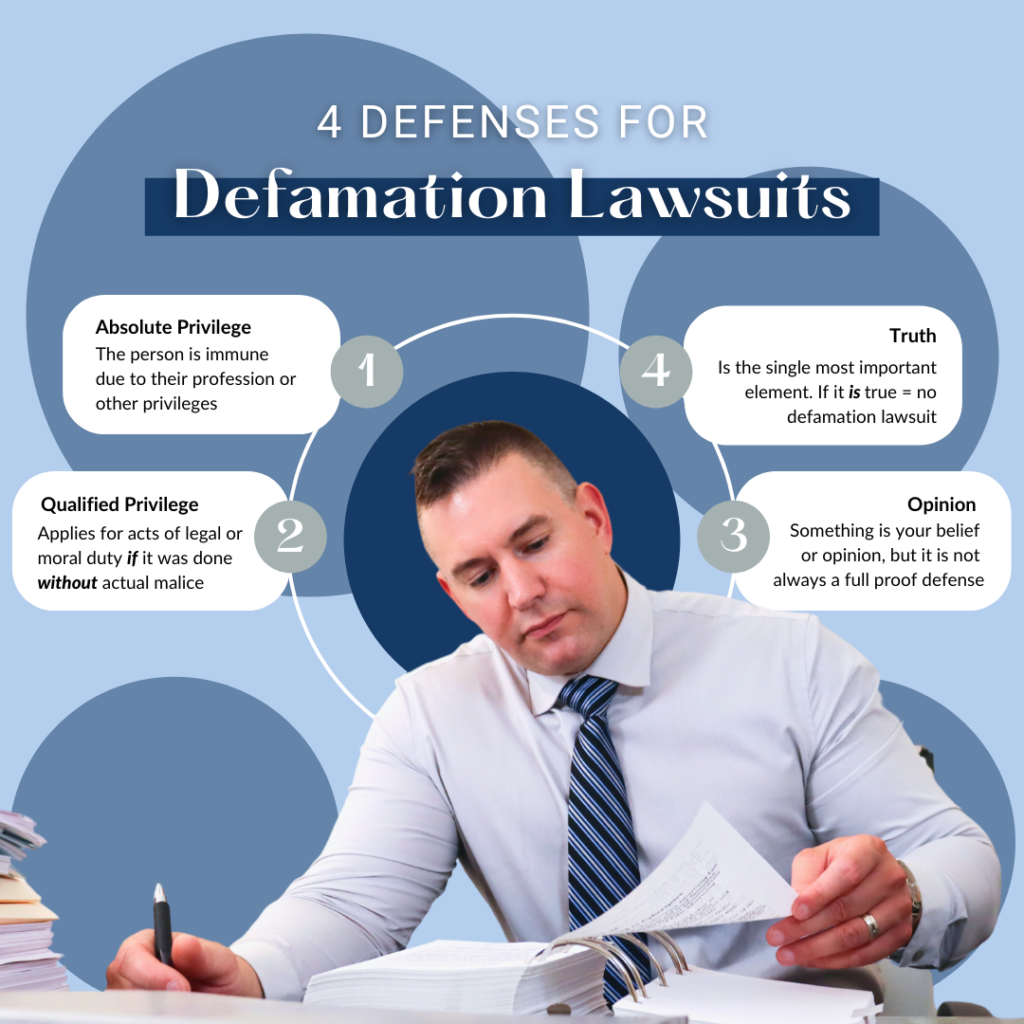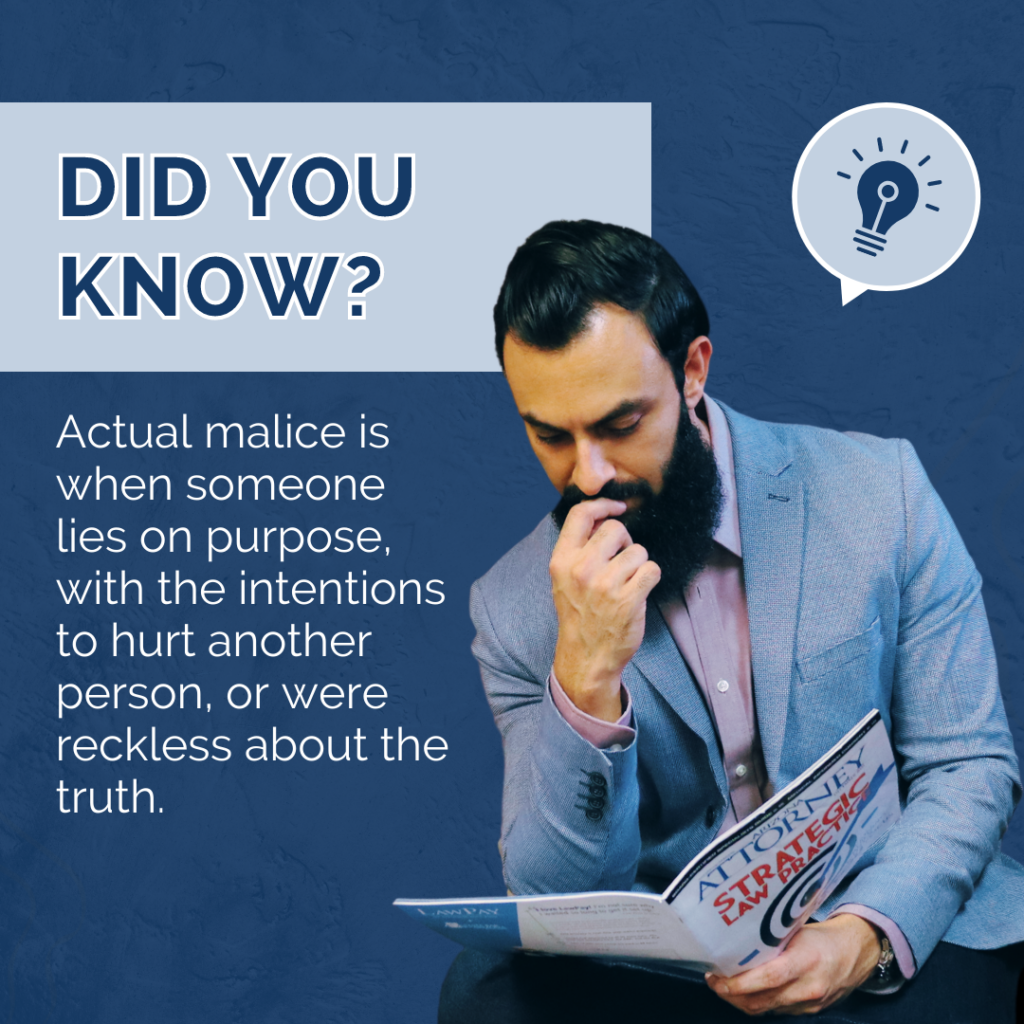What Is Actual Malice In A Defamation Lawsuit?
What Is Actual Malice In A Defamation Lawsuit?

What is actual malice in a defamation lawsuit? If you are curious about defamation law or are currently involved in a defamation lawsuit, you may have come across the term “actual malice” and wondered “what does this mean?”, “who has to prove actual malice?” or “how can I prove actual malice in my case?” Not to worry, our defamation lawyers know how to answer your questions about actual malice in defamation cases. Let’s jump right in.
Definitions of Actual Malice
How to prove actual malice in a defamation case may vary, jurisdiction to jurisdiction. Additionally, in most jurisdictions, you must prove actual malice in order to win your defamation lawsuit if the plaintiff is a public figure or limited purpose public figure. You may also be entitled to punitive damages if you can show that the false and defamatory statements were published with actual malice. See the infographic to learn more about the types of damages awarded in defamation lawsuits:
To find your state’s defamation law, visit our state-by-state defamation law guide.
The most commonly used explanations of actual malice in a defamation case are stated below:
Formal Legal Definition of Actual Malice in the Defamation Context:
A person considered a public figure must prove by clear and convincing evidence that the statement was made with actual malice, which means falsity (knowing the statement to be false) or a reckless disregard for its truth. See Currier v. W. Newspapers, Inc., 175 Ariz. 290, 292, 855 P.2d 1351, 1353 (1993) (citing New York Times v. Sullivan, 376 U.S. 254, 279–80, 84 S.Ct. 710, 11 L.Ed.2d 686 (1964)); Restatement (Second) of Torts § 580A (1977). This standard comes from an Arizona defamation case, Xcentric Ventures, LLC v. Brewington, but references the pinnacle case on malice, the New York Times v. Sullivan case (explained below).
The Restatement Second of Torts provides us with more insight on what it means to show actual malice in a defamation case:
A public person must prove that the defamatory “statement was made with ‘actual malice’—that is, with knowledge that it was false or with reckless disregard of whether it was false or not.” New York Times Co. v. Sullivan, 376 U.S. 254, 279-80, 84 S.Ct. 710, 725-26, 11 L.Ed.2d 686 (1964), motion denied, 376 U.S. 967, 84 S.Ct. 1130, 12 L.Ed.2d 83. See also Garrison v. Louisiana, 379 U.S. 64, 74, 85 S.Ct. 209, 215, 13 L.Ed.2d 125 (1964) (“false statements made with [a] high degree of awareness of their probable falseness”); St. Amant v. Thompson, 390 U.S. 727, 731, 732, 88 S.Ct. 1323, 1325, 1326, 20 L.Ed.2d 262 (1968) (requirement “that the defendant in fact entertained serious doubts as to the truth of his publications”; “so inherently improbable that only a reckless man would have put them in circulation”). These cases specifically state that the test is not negligence. See Restatement (Second) of Torts § 580A (1977), comment “d”.
“Actual malice is a statement made with a reckless disregard for truth. Actual malice can be established through circumstantial evidence. High degree of awareness of falsity is required to constitute actual malice. If the plaintiff is a public figure, the plaintiff should prove by convincing evidence that the defendant published a defamatory statement with actual malice…” -USLegal
Simplified Actual Malice Definition:
Actual malice is best described as when someone lies on purpose, with the intentions to hurt another person, or were reckless about whether the statement was true or not but said it anyway. For example, if a famous person wanted to sue someone over lies, actual malice is required. They must prove that those accused lied on purpose, or at least had ill-will when the statements were made.
So what is actual malice in the context of a defamation action? Let’s explore some actual malice examples that will help us better our understanding of actual malice in libel, actual malice elements, and perhaps answer the question “why do public figures have to prove actual malice?”.
Hypothetical Examples of Actual Malice Lawsuits
Local Politician/Business Owner Suing Competing Business:
Shane’s Shoes – a fictional shoe store in Littleton, Colorado- needs to draw customers to the store. Shane is in a hurry to show his parents that he can succeed on his own, so he comes up with the perfect way to gain customers fast. Shane creates a website slamming the competing shoe store, Frank’s Footwear (Frank also happens to be a town councilor and uses his political role to drive business).
Shane’s website alleges that Frank’s shoes are made by child laborers in Thailand. Shane advertises the website on Facebook and targets all the residents in Littleton. Soon, the whole town has heard that Frank’s Footwear uses child labor to make their shoes. Consequently, Frank’s business suffers, and he is voted off the town council.
If Frank were to sue Shane for defamation, he would most likely need to prove actual malice to win because he is a local politician. In most jurisdictions, public officials- whether they’re the President or a small-town official- automatically fall into the “public figure” category.
On the other hand, if Frank won the local election, but his footwear business suffered due to Shane’s Internet lies, Frank may not need to prove actual malice. This is because the case would have nothing to do with his government standing, and entirely with his business matters. So, instead of a public official, Frank would be considered a private business owner.
The Case of the Teacher Twitter War:
Stacy Smith is a sixth-grade math teacher and so is her arch nemesis, Tina Thompson. Both teach at a school that recently announced cutbacks and one of the sixth-grade math teachers will be let go soon. Stacy tweets “Either Tina or I will be fired because of cutbacks. I hate her and hope the administration sees how awful she is.” Tina sees the tweet and fires back tweeting, “Stacy is a total fraud. The only reason her students score so well is because she lets them cheat on standardized tests.”
Now, let’s assume that Stacy doesn’t help students cheat and that the state the two teach in has defamation laws that define public school teachers as limited purpose public figures (this is common in multiple jurisdictions).
In this hypothetical situation, Tina is the one who could be at fault for defamation, not Stacy. This is because under U.S. law, opinions aren’t statements of fact, but lying about an individual, group, or business with intentions to harm, is a civil wrong. If Stacy were to sue Tina for defamation, she would need to prove actual malice in order to win because they both live in a state that treats public school teachers as limited purpose public figures. Stacy could argue that Tina purposely lied in attempt to get her fired so Tina could keep her job, which could possibly satisfy the actual malice standard.
The Tale of the Celebrity and the Gossip Site:
PMZ published a harsh story about Courtney Cardashian’s recent child custody issues. The story appeared online and in print with the headline reading, Courtney Cardashian Abandons Her Kids! Courtney refutes the article insisting that she almost always is with her children. She then decides to sue PMZ for libel. Let’s assume here, that PMZ is not satirical and is not publishing an editorial article, but facts.
In this hypothetical situation, Courtney would need to prove actual malice in order to win because of her celebrity status. She would need evidence that proves PMZ caused her material harm and that the publication knew it was publishing a false story, or was reckless in ascertaining the truth, but did it anyway.
To make things interesting, let’s say a car seat company pays Courtney to endorse their car seats on her Instagram. The company decides to end their partnership because of PMZ’s story. If this happened, Courtney could prove monetary loss.
On the other hand, if Courtney just doesn’t like the insinuation and can’t prove evidence of falsity and harm, winning a defamation lawsuit would be very hard for her. In addition, PMZ would likely cite a “reliable source” and argue that their reporters had no reason to doubt the accuracy of the claims. PMZ will also argue a common publication defense, that they are not required to investigate all the details of their story before publishing it.
Now, if Courtney was a private citizen instead of a celebrity, she would most likely only be required to meet the “negligence” standard instead of proving actual malice. This means she would need to prove that “a reasonable person” would not have published the accusation.
The Case That Started It All: New York Times Co. v. Sullivan
The first lawsuit that established “actual malice” as an element public figures must meet in slander and libel lawsuits was the famous United States Supreme Court case, New York Times Co. V. Sullivan- 1964.
In March of 1960, the New York Times ran a full-page advertisement called “Heed Their Rising Voices” in support of Dr. Martin Luther King, Jr.
The Montgomery public safety commissioner L.B. Sullivan was offended by the ad because it claimed that Alabama police were mistreating civil rights activists, including for example, that they had arrested King seven times when he had only been arrested four times. There were many other inaccuracies in the reporting as well. Even though the ad never mentioned Sullivan by name, he wrote a letter to the New York Times asking them to retract the ad. He did so because at the time, Alabama statutes prevented plaintiffs from collecting punitive damages without proof of a retraction request denial.
Instead of retracting, the New York Times sent Sullivan a letter expressing their confusion as to why he felt that the statements reflected him. In response, Sullivan sued the publication for libel.
The trial court ruled the statements by the press were defamatory per se and awarded Sullivan $500,000 in damages. The Alabama Supreme Court affirmed this decision. But the case was appealed to the United States Supreme Court where the court ultimately weighed the constitutionally of Alabama’s defamation law. In the end, the Supreme Court justices voted unanimously in favor of the New York Times, and overturned the lower court’s decision, because Alabama’s slander and libel statues did not provide enough safeguards for free speech.
In order to ensure a healthy free press, SCOTUS also declared that defamation cases filed by public figures must prove “actual knowledge of falsity” when they involve matters of public interest.
RM Warner founding partner Raees Mohamed has this to say about the practicalities of proving actual malice in a defamation case: “Proving actual malice in a defamation case is not easy, and that is because we often do not have any direct evidence of actual malice. Often, we are stuck trying to prove malice during the discovery phase of litigation, through depositions, or through other documentary evidence where the defendant is talking about how much they despise the plaintiff. Sometimes, we can obtain the relevant evidence for malice from third parties using subpoenas. Once in a while, we will get lucky and find an abusive defendant that has made many public statements about the plaintiff and will specifically state that they did not care about how it impacted the defendant or other vitriolic statements. Ultimately, it’s tough, and each case needs to be evaluated on a case by case basis.”
For other potential defamation defenses, check out the infographic:

In Need of a Defamation Lawyer?
If you are seeking help from an experienced Internet defamation attorney, look no further than RM Warner Law. Our lawyers know exactly how to litigate cases for both public and private figures so get in contact today.
3 Comments
Leave A Comment
Similar like this
You also might be interested in
Why Influencer Lawsuits Are on the Rise: And What It Means for the Industry
The influencer marketing industry has grown significantly over the past [...]
How to Remove Defamatory Content from the Internet: Legal Options Explained
In today’s digital world, defamatory content can spread quickly online, [...]
What’s the Difference Between Libel and Slander? A Legal Breakdown
A false statement can spread quickly and damage someone’s reputation, [...]
How a Cyber Harassment Lawyer Can Help You Fight Online Abuse
The internet has changed the way we communicate, but it [...]







Hi there, You’ve done an excellent job.
I will definitely digg it and personally recommend to my friends.
I am confident they will be benefited from this site.
This definitely be the next preference. You are perfect, theme team. I Really enjoy the system, fonts along
Excellent blog here! Also your site loads up very fast!
What web host are you using? Can I get your affiliate link to your
host? I wish my wweb site loaed up as quickly as yours lol
http://cse.google.com.sl/url?q=https://comprarcialis5mg.org/
Kellie (Kellie) http://cse.google.com.tr/url?q=https://comprarcialis5mg.org/